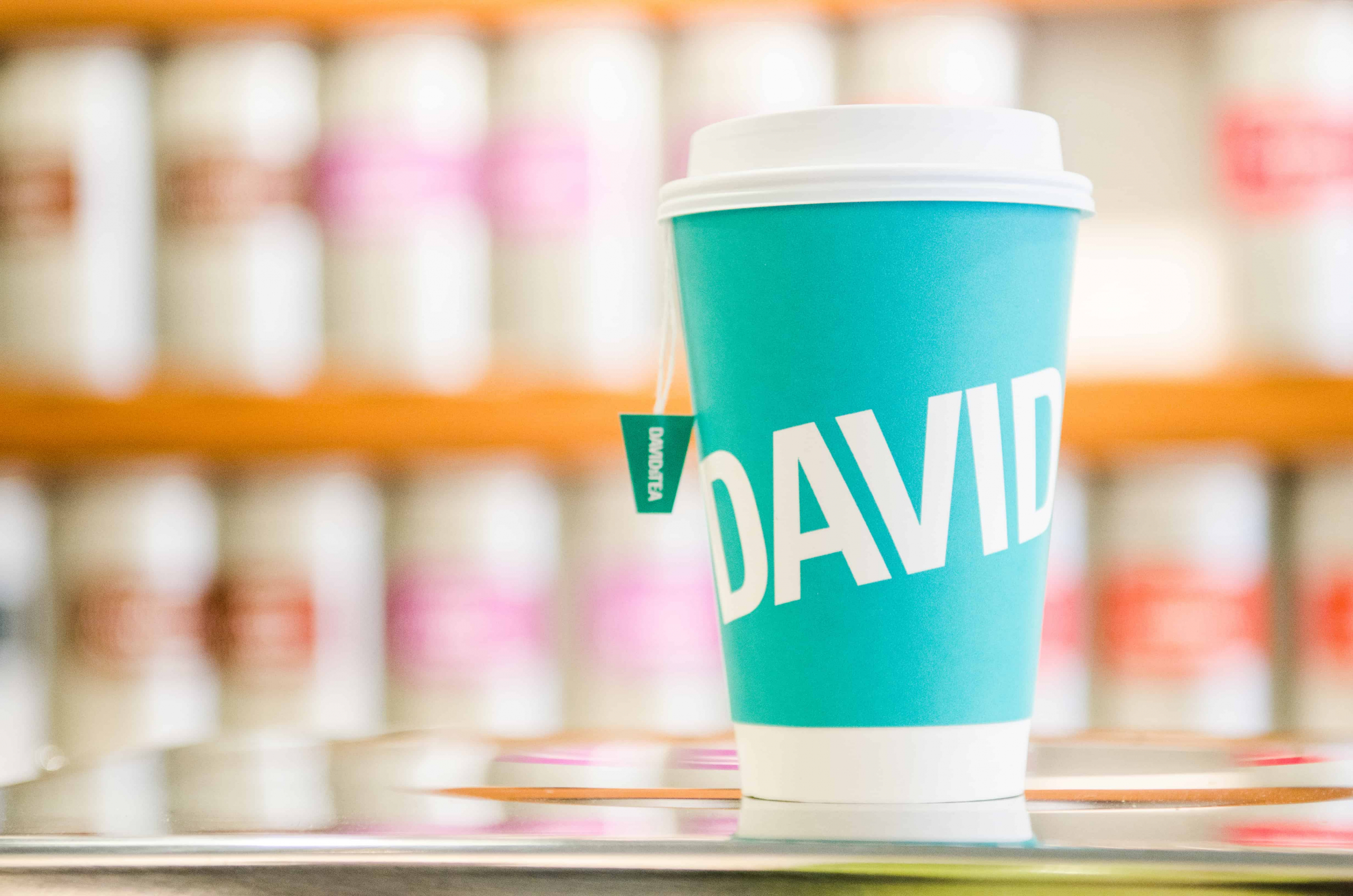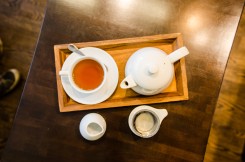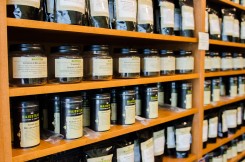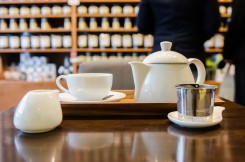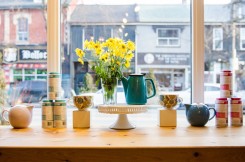It was less than two decades ago that franchise coffee houses began cropping up on practically every street corner in Toronto. These new cafés offered exotic roasts, flavoured lattes, and an experience — a seductive combination of earth-toned sofas, smooth jazz soundtracks, and free Wi-Fi. Coffee was suddenly accessible and fun, and drinking coffee has since become a ubiquitous feature of city life. We grab coffee, meet for coffee, place orders for coffee using strings of adjectives that would be unintelligible to earlier generations of coffee-drinkers: “I’ll have a tall, non-fat, no-whip, six-pump, extra-hot, cinnamon dolce latte.”
If you decide to forego said latte in favour of tea, more often than not, you’ll get a single tea bag slapped into a cup of boiling water. Though it is the most consumed drink in the world, tea has received considerably less glory than its hot beverage cousin in North America, having been eclipsed by a dominant coffee culture. But this is quickly starting to change.
Tea consumption is on the rise in Canada and is expected to increase by 40 per cent over the next seven years. In Toronto, this trend is reflected in the number of specialty teashops that have recently opened up across the city. In addition to Toronto’s independent teahouses, the American chain Teavana (which was purchased by Starbucks this past December) recently made its Toronto debut, and teal DavidsTea cups can be spotted with increasing frequency in the hands of bustling pedestrians.
Torontonians are drinking more tea than ever before, and they are drinking it differently. But what has prompted this explosion in tea consumption? And what, if anything, makes the city’s contemporary tea culture distinct from tea-drinking practices that have persisted across the world for centuries?
Beginnings
Tea is an aromatic beverage, which, in its most basic form, consists of hot water and the leaves of a plant called Camellia sinensis. “Herbal tea” is technically not a true tea. Made from herbs, spices, and fruit (rather than Camellia sinensis), this infused drink is referred to by tea experts as a “tisane.”
The many varieties of tea that are available today — green, white, black, oolong, and so on — are all derived from the Camellia sinensis plant, but each type of tea is processed differently. Black tea, for example, undergoes a high degree of oxidization (fermentation), while green tea is oxidized only slightly. The geographic locations of tea farms also contribute to nuances in tea flavour; the delicate Darjeeling tea hails from India, the earthy Pu-erh from China, and the full-bodied Ceylon from Sri Lanka.
Although the early history of tea is obscure, the beverage may have originated in China during the Shang dynasty. The British began importing tea leaves from Asia in the 1600s, and tea came to North America with European settlers during the colonial period.
It was the rise of the tea bag — a twentieth century American invention — that arguably created one of the biggest rifts between traditional and contemporary tea-drinking practices. Tea bags usually contain “fannings,” a very fine grade of tea leaf. While it is certainly possible to find tea bags that offer a high-quality product, many of the tea bags that are sold in supermarkets are stuffed with the dregs of a tea crop, the crushed leaves that remain after whole tea leaves have been filtered and packaged as loose-leaf.
Tradition?
While loose-tea traditions have persisted in Europe, Africa, and Asia, the tea bag has taken over the North American market. For many years, consumers have been willing to forgo vibrant and chunky loose-leafs, sacrificing quality for the sake of convenience.
Yet in Toronto and other North American cities, there has been a resurgence of demand for high-quality teas. A number of Asian-style tea houses are scattered across Toronto, while other tea stores in the city are modeled after traditional British shops. Among the latter category is Majesteas, a specialty loose-leaf store in Leslieville.
Majesteas is a tiny space, dominated by a rich mahogany display case that is lined with rows of tea jars. Plates of scones sit on the counter by the cash register, and in true English fashion, tea at Majesteas is served in a teapot.
The shop was founded three years ago by Ian Macdonald and Robert Gignac. According to Macdonald, who is a certified tea sommelier, the rising popularity of loose-leaf tea is due in part to the slow but steady realization that the average tea bag simply cannot compete with the rich flavour of loose blends.
“Europeans have always had no problem with loose-leaf tea,” he says. “It’s a much higher quality than the stuff in the tea bag… I think that people have slowly come to try loose leaf tea and say, ‘Oh, this actually does taste a lot better than tea bags.’”
Macdonald also explains that an increasing number of his customers are former coffee drinkers, who have decided to cut down on their caffeine intake and are looking for a substitute beverage.
“Now with people being stressed, and university students staying up and studying, people drink too much coffee,” he says. “And the effects of that aren’t so great for you in the long run… There isn’t that much caffeine in tea.”
Although Majesteas stocks a diverse range of tea blends, its selection is relatively conservative. Macdonald points out that Majesteas has deliberately steered clear of “gimmicky tea, which is tea with little bits of candy in it.” The shop instead offers fruity herbal teas, Asian blends, and, of course, an assortment of breakfast teas, the robust black tea that is popular in England.
That said, Majesteas is a far cry from the fusty Old English tearooms decorated with lace tablecloths and Royal Daltons. The shop is light and modern, with cool green walls and soft, cushiony chairs. Majesteas also offers a number of playfully named blends, such as “Buckingham Palace Garden Party,” “Cheeky Monkey!” and “Leslieville Picnic Blend.”
Perhaps most importantly, Majesteas’ tea-wall is not located behind the cash. This allows customers to browse through the teas at their own pace, to pull jars down from the walls, sniff the blends, and decide what they want to taste. According to Macdonald, this “grocery store” model makes the customer’s tea experience more inviting and accessible.
“Our idea was that people can open the glass jars, they can read about the tea, they can smell and self-discover different kinds of tea,” he says. “That’s the main thing that makes us different from other places — you can self-discover, and then have a cup of tea and try it.”
Modernity
Tealish on Queen West is another boutique tea store that strives to put a new twist on an old beverage. The shop is beautiful and bright, with a large storefront window and small seating area in the back of the shop. The store’s exposed brick tea-wall is lined with huge metal tins, each one stamped with pastel labels designed by the Tealish staff. The teas inside the tins are all blended locally, and some of them are created in Tealish’s basement.
Alyssa Garrison, assistant manager at Tealish, explains that many of the store’s customers first visit the shop while seeking out the health benefits of premium loose-leaf tea.
“Green tea boosts your metabolism and it’s a really high anti-oxidant, so that one is popular,” she says. “And then we also have Yerba Mate… It’s full of vitamins and minerals, and because it’s so nutrient-dense, it actually works as an appetite suppressant. So that one is really, really popular.”
But the salutary property of tea is not the only thing driving customers to Tealish. To put it simply, drinking tea at Tealish is fun. The store only uses ingredients that are, according to Garrison, “really clean and really natural,” yet Tealish offers an exciting variety of blends featuring creative combinations of flavours and ingredients. Among the store’s signature teas are “Caramel Apple Rooibos,” “Pink Dragonfruit” and the best selling “Toasty Almond.” Tealish also sells tea smoothies, tea lattes, and iced teas.
According to Garrison, the modernization of tea has been a driving force behind the drink’s rising popularity. She also believes that innovative tea blending is a defining feature of contemporary tea culture in Toronto and other North American cities.
“[Tealish] opened ahead of the tea trend curve,” she says. “And then this happened. The crazy tea attack. Everyone knows tea, everybody has a tea cupboard. I think a big part of it is that teashops got a lot more modern and approachable. Before, a lot of the teashops were either Old English … or very Asian style.
“The rise of new, more fun tea shops has both made those origin teas a lot more approachable for people and introduced a whole other blended tea thing, which I think is pretty unique to North America. I’ve talked to a lot of people from of other countries, and … they don’t have fancy blended teas… Because teas are being presented in a really fun way [in North America] … there’s pretty much something for everyone.”
Commercialism
Making tea accessible to the masses has been key to the success of DavidsTea, the Canadian tea chain that burst onto the market in 2008. Like Tealish, DavidsTea offers a vast array of innovative loose-leaf blends. In addition to staples like “Spearmint” and “English Breakfast,” the store’s 150 unique blends include “Chocolate Chili Chai,” “Cheeky Lychee,” and “Red Velvet Cake.”
“We love tea and we love sharing our passion for tea with our customers,” says DavidsTea representative Bradley Grill. “We’re just all about making tea fun and accessible, whether you’re new to tea or not.”
Some DavidsTea blends include ingredients that would probably offend the sensibilities of stringent tea purists — sprinkles, chocolate, yogurt pieces, and caramel can be found in several of the company’s select teas. Yet DavidsTea sources its tea from some of the world’s finest estates and gardens, and uses organic ingredients whenever possible. The company is, essentially, providing high quality loose tea, but taking liberties with blending traditions in order to makes its product palatable for an expanding market of tea-drinkers.
This approach to tea seems to be working; DavidsTea now has over 100 locations across the US and Canada.
Horizons
The rising popularity of tea in Toronto seems to have been prompted by Torontonians’ desire to drink something different, something healthful, something better than the standard brand of tea that you can buy in a supermarket. Yet the loose-leaf tradition has resurfaced in a notably different form. Tea has been modernized to suit the tastes of a contemporary market. It is fun, it is delicious, and it offers endless possibilities for blending scents, ingredients, and flavours. When it comes to drinking tea, there is so much to learn and so much to explore.
Brewing Tips from Ian Mcdonald, owner of Majesteas.
– Green tea is sensitive to boiling water (which can give it a bitter taste). To make the perfect cup of green tea boil your water then let it sit for about 5 minutes, the temp will have come down enough to be ok for green tea. Then steep your green tea for 2-3 minutes then take your filter out. Keeping the leaves in will stew your tea and make it bitter.
-The length of time is important for tea, quality black tea will steep to perfection in 3-4 minutes (a little longer for a stronger brew). Try it black sometime, you’ll be amazed you might not want sugar or milk in it if it’s a good quality tea!
– Pu-erh tea can be steeped more than once and is great for digestion, simply remove your filter (or leaves) when you drink your tea then pop it back in when you’re ready for another pot or cup.
– Quality oolong teas use the full tea leaf and can be steeped multiple times. With each steeping the flavour becomes more subtle but the flavour profile also changes, it’s wonderful.
– Quality loose leaf tea is a much higher grade than what you get in tea bags and should be stored in air tight dark packaging to maintain its flavour.
View Toronto with a tea in a larger map

